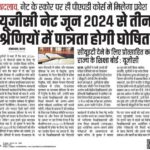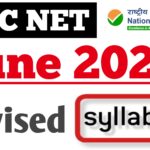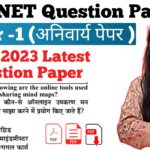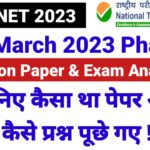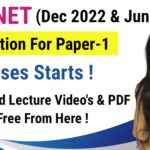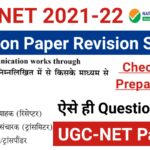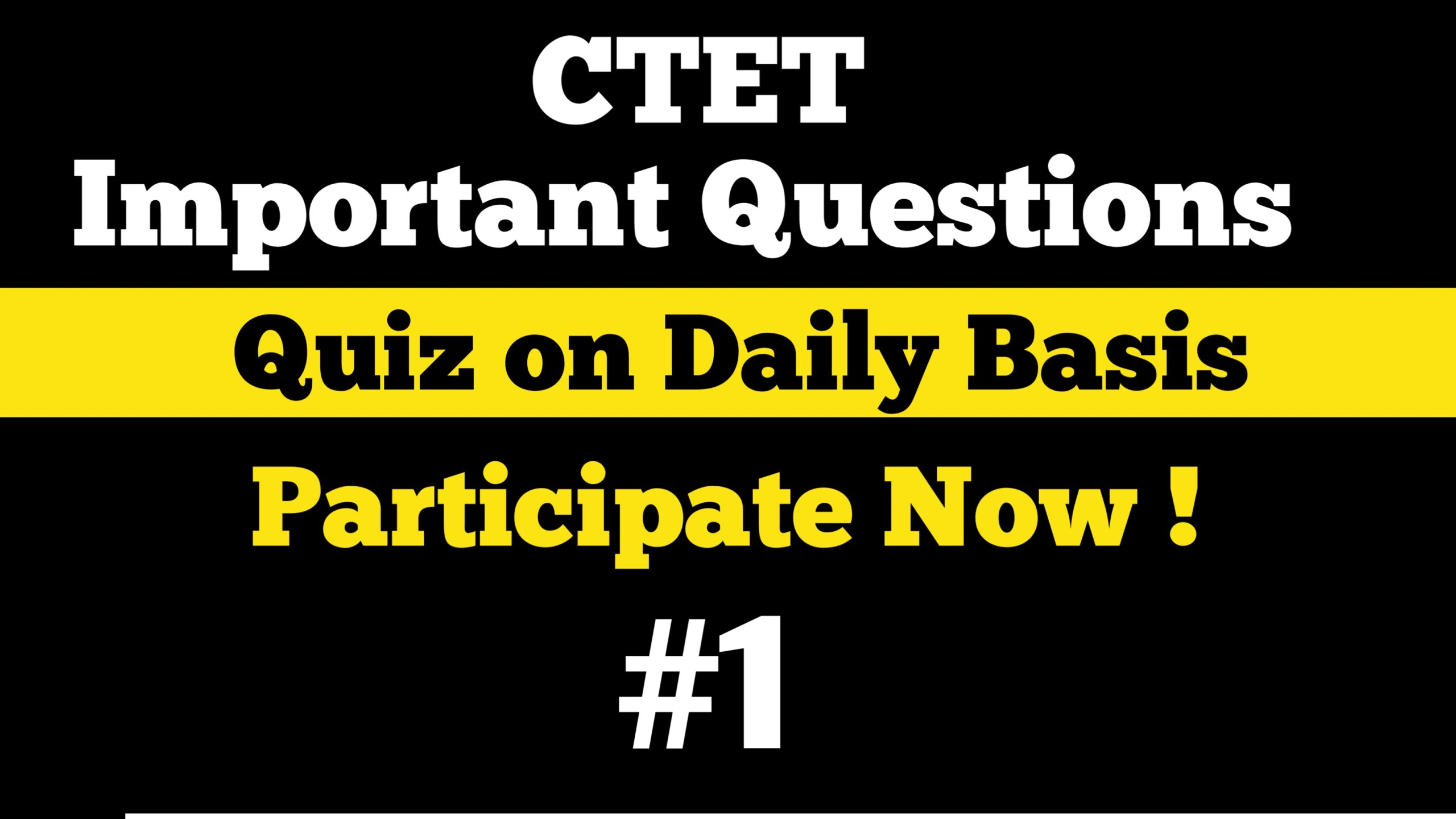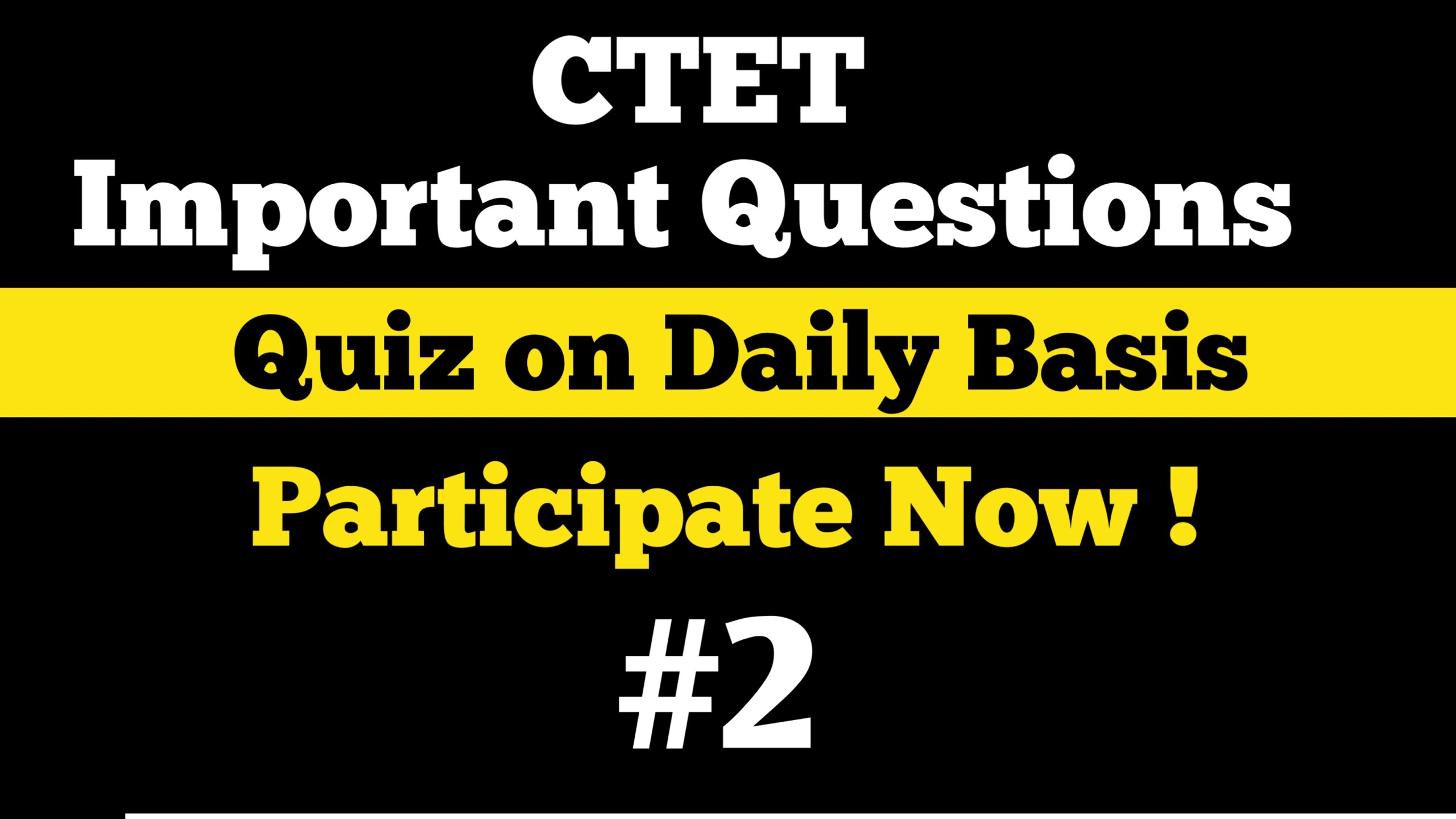Thinking Styles MCQ Quiz – Objective Question with Answer for Thinking Styles
Which of the following is/are a tool(s) of thinking?
I. Mind maps
II. Cognitive Research Trust (CoRT)
III. Concepts
- Both I and II
- Both I and III
- Both II and III
- I, II and III
Answer (Detailed Solution Below)
Option 4 : I, II and III
Thinking Styles MCQ Question 1 Detailed Solution
 Key Points
Key Points
- Thinking tools are instruments that are designed to enhance different aspects of thinking in individuals for crucial cognitive development.
- It helps individuals to generate and use innovative ideas more systemically and effectively.
- A Thinking Tool is an instrument that can help us in using our minds systematically and effectively.
- With the use of thinking tools, the intended ideas will be arranged more systematically, clearly, and easy to be understood.
 Important Points
Important Points
The four main tools of thinking are :
- Mind maps
- CoRT
- Concepts
- Questioning
Concept:
- They are general ideas that we use to identify and organize our experiences.
- Words are the vocabulary of language; Concepts are the vocabulary of thought.
Structure of Concepts:
- Sign – word/symbol that names the concept.
- Reference – examples of the concept
- Properties – qualities that all examples of the concept share in common.
Cognitive Research Trust (CoRT)
- It is a tool to assess the implementation of higher-order thinking skills in the teaching-learning process.
- It is designed to enhance different aspects of thinking in students for crucial cognitive development.
Mind maps
- Mind maps are diagrams that visually organize information. It was developed by Tony Buzan.
- It makes both the left and right brain work and thinks.
- The information is organized on the mind map in order of the importance of concepts.
- Some of the applications of mind mapping are note-taking, brainstorming sessions, studying, etc.
Hence, we conclude that all the above points are thinking tools.
Thinking Styles MCQ Question 2
A five years old child will have following type of thinking
- Reflective thinking
- Directed thinking
- Concrete thinking
- Logical thinking
Answer (Detailed Solution Below)
Option 2 : Directed thinking
Thinking Styles MCQ Question 2 Detailed Solution
Thinking is a higher mental process. It is the orderly development of mental and intellectual processes, like logical thinking, making sense of new ideas, solving problems, and the like, that takes place over a period of time.
The pattern of Thinking at different stages of development:
| Development Years | Thinking Patterns |
| 0-2 yrs | In the initial years of this phase, the infant’s thinking is not developed enough to understand that objects continue to exist even if he cannot see/sense them. |
| 2-7 yrs | At this stage, the child becomes capable of engaging in goal-directed activities and develop directed thinking. |
| 7-11 yrs | The child’s thought is based on material reality. That is, her/his logic is tied to the concrete world. At this stage, he/she develop concrete thinking. |
| 11 years till Adulthood | It is only in this stage that children’s capacity to think mathematically emerges. Such thinking demands the ability for hypothetical, logical thinking, and reflective thinking. |
Types of Thinking
- Directed thinking- It refers to controlled and purposeful thinking that mainly focuses on a particular goal, such as the solution to a problem, and guided by the requirements of that goal.
- Reflective Thinking– This thinking is about going back into the past experiences and recollecting what you did or did not do in a given situation.
- Concrete thinking– It is the simplest form of thinking, carried out for the perception of a concrete object.
- Logical thinking– It is the process in which a child uses reasoning to come to a closure.
Thinking Styles MCQ Question 3
According to ‘Six Thinking Hats’, which of the following colours optimism pays attention to problems?
- Green
- Black
- Blue
- Yellow
Answer (Detailed Solution Below)
Option 4 : Yellow
Thinking Styles MCQ Question 3 Detailed Solution
Six Thinking Hats: The premise of the method is that the human brain thinks in a number of distinct ways which can be deliberately challenged, and hence planned for use in a structured way allowing one to develop tactics for thinking about particular issues. Edward De Bono identifies six distinct directions in which the brain can be challenged. In each of these directions, the brain will identify and bring into conscious thought certain aspects of issues being considered. Six distinct directions are assigned a colour:
- White: focuses on Data and information
- Red: focuses on feelings, intuition, emotion
- Yellow: focuses on Optimism, benefits
- Black: focuses on Caution, Critical judgment
- Green: focuses on Creative thinking
- Blue: focuses on Process control, thinking about thinking (metacognition)
Thinking Styles MCQ Question 4
A teacher who practices a good mix of creative expressions with other approaches, encourages children to have _______ thinking.
- Converagent
- Divergent
- Minimal
- Short-term
Answer (Detailed Solution Below)
Option 2 : Divergent
Thinking Styles MCQ Question 4 Detailed Solution
Thinking is the base of all cognitive activities or processes and is unique to human beings. It involves the manipulation and analysis of information received from the environment.
 Key Points
Key Points
J.P. Guilford, a pioneer in creativity research, proposed two types of thinking: convergent and divergent.
- Convergent Thinking: It refers to close-ended thinking that is required to solve problems that have only one correct answer. The mind converges to the correct solution. It is based on a number series, where you have to find the next number. Only one right answer is expected.
- Divergent Thinking: It is open-ended thinking where the individual can think of different answers to the questions or problems in terms of her/his experiences. Such kind of thinking helps in producing novel and original ideas. Divergent thinking abilities generally include fluency. The practice of a good mix of creative expressions with other approaches encourages children to have divergent thinking.
Hence, it concludes that a teacher who practices a good mix of creative expressions with other approaches, encourages children to have divergent thinking.
Thinking Styles MCQ Question 5
Which of the following techniques can be used for improving the power of thinking?
I. Models of teaching
II. Remedial teaching and instruction
III. Curriculum development
IV. Evaluation and diagnosis
- I, III and IV
- I, II and III
- I, II, III and IV
- II, III and IV
Answer (Detailed Solution Below)
Option 3 : I, II, III and IV
Thinking Styles MCQ Question 5 Detailed Solution
Education is the process of human development.
 Key Points
Key Points
- Thinking is the mental process of manipulating information to draw a conclusion or to generate ideas.
- Intellectual or mental development is possible by improving the power of thinking. For improving the thinking process, the teacher should try to understand his students and the devices for better thinking.
- Teaching and instructions are planned and organized for improving the power of thinking.
 Important Points
Important Points
The following are the devices or techniques used for improving the power of thinking.
- Mind mapping
- Picture reading
- Models of teaching
- Open-ended questions
- Curriculum development
- Evaluation and diagnosis
- Problem-solving activities
- Remedial teaching and instruction
Thinking Styles MCQ Question 6
Questions encouraging students to voice their individual opinions on issues and reflections while giving reasons for the same, promote:
- Convergent thinking
- Recall of information
- Standardized assessment of children
- Analytical and critical thinking
Answer (Detailed Solution Below)
Option 4 : Analytical and critical thinking
Thinking Styles MCQ Question 6 Detailed Solution
Questions refer to the problem or difficulty that needs to be solved by thinking and recalling the concept.
- It leads to the cognitive development of students by stimulating their thinking skills and imagination power.
- Questions encouraging students to voice their individual opinions on issues and reflections while giving reasons for the same promote analytical and critical thinking of learners.
Important Points
Analytical and critical thinking are higher cognitive functions that make learners able:
- to approach an issue with an open-ended mind.
- to look at any issues from different points of view.
- to understand how issues are related to their own lives.
- to make logical connections between ideas by thinking rationally.
- to increase their own insight into the functioning of several things.
- to assess information and draw conclusions from the given raw data.
- to perceive any issues effectively to come up with the best possible inference.
Thinking Styles MCQ Question 7
Which of the following type of thinking is characterized by a predominance of actual objects and events and the absence of concepts and generalization?
- Deductive thinking
- Inductive thinking
- Concrete thinking
- Abstract thinking
Answer (Detailed Solution Below)
Option 3 : Concrete thinking
Thinking Styles MCQ Question 7 Detailed Solution
“Thinking is the hardest work there is, which is probably the reason why so few engage in it”–Henry Ford
According to Garrett, thinking is a behaviour which is often implicit and hidden and in which symbols (ideas, images, and concepts) are ordinarily employed.
Types of Thinking:
- Convergent thinking is the type of thinking that focuses on coming up with the single, well-established answer to a problem. It is oriented toward deriving the single best, or most often correct answer to a question.
- Divergent thinking involves breaking a topic down into its various component parts in order to gain insight into the various aspects of the topic.
- Abstract thinking is characterized by the ability to use concepts and to make and understand generalizations, such as the properties or pattern shared by a variety of specific items or events.
- Concrete thinking is characterized by a predominance of actual objects and events and the absence of concepts and generalizations.
- Reflective thinking is a part of the critical thinking process referring specifically to the processes of analyzing and making judgments about what has happened. Dewey (1933) suggests that reflective thinking is an active, persistent, and careful consideration of a belief or supposed form of knowledge, of the grounds that support that knowledge, and the further conclusions to which that knowledge leads.
- Inductive thinking process is often referred to as “generalizing” because it essentially means that one begins with specific details or facts and progresses to a general principle as a conclusion. It is based on probability, not certainty.
- Deductive thinking claims that it’s logically necessary that if the premises are all true then so is the conclusion.” If deductive logic is used accurately and correctly, accurate points or arguments will lead to an accurate conclusion or result.
- Logical thinking is the process in which one uses reasoning consistently to come to a conclusion. Problems or situations that involve logical thinking call for structure, for relationships between facts and for chains of reasoning that make sense.
Thinking Styles MCQ Question 8
Which of the following is not a method of stimulating divergent thinking?
- free writing
- Mind calibrating
- Keeping a Journal
- Brainstorming
Answer (Detailed Solution Below)
Option 2 : Mind calibrating
Thinking Styles MCQ Question 8 Detailed Solution
The goal of divergent thinking is to generate many different ideas about a topic in a short period of time. It involves breaking a topic down into its various component parts in order to gain insight into the various aspects of the topic. Following divergent thinking, the ideas and information will be organized using convergent thinking; i.e., putting the various ideas back together in some organized, structured way. Methods that stimulate divergent thinking:
- Brainstorming: A technique which involves generating a list of ideas in a creative, unstructured manner. The goal of brainstorming is to generate as many ideas as possible in a short period of time. The key tool in brainstorming is “piggybacking”, or using one idea to stimulate other ideas.
- Keeping a Journal: Journals are an effective way to record ideas that one thinks of spontaneously. By carrying a journal, one can create a collection of thoughts on various subjects that later become a sourcebook of ideas.
- Free-writing: When free-writing, a person will focus on one particular topic and write non-stop about it for a short period of time. The idea is to write down whatever comes to mind about the topic, without stopping to proofread or revise the writing. This can help generate a variety of thoughts about a topic in a short period of time, which can later be restructured or organized following some pattern of arrangement.
- Mind or Subject Mapping: Mind or subject mapping involves putting brainstormed ideas in the form of a visual map or picture that that shows the relationships among these ideas. One starts with a central idea or topic, then draws branches off the main topic which represent different parts or aspects of the main topic. This creates a visual image or “map” of the topic which the writer can use to develop the topic further.
- Six Thinking Hats: The premise of the method is that the human brain thinks in a number of distinct ways which can be deliberately challenged, and hence planned for use in a structured way allowing one to develop tactics for thinking about particular issues. Edward De Bono identifies six distinct directions in which the brain can be challenged.
- White- focuses on Data and information
- Red- focuses on feelings, intuition, emotion
- Yellow- focuses on Optimism, Benefits
- Black- focuses on Caution, Critical judgment
- Green- focuses on Creative thinking
- Blue- focuses on Process control, thinking about thinking (metacognition)
Thinking Styles MCQ Question 9
Which of the following statements about children’s thinking is NOT correct?
- Children actively think about various phenomenon around them and have an urge to explore.
- Children are born with curiosity to learn about the world around them.
- Children construct their own theories about various phenomenon around them.
- Children cannot think of concepts on their own and the primary role of teachers is to provide information.
Answer (Detailed Solution Below)
Option 4 : Children cannot think of concepts on their own and the primary role of teachers is to provide information.
Thinking Styles MCQ Question 9 Detailed Solution
Thinking is the base of all cognitive activities or processes and is unique to human beings. It involves manipulation and analysis of information received from the environment. Thinking, therefore, is a higher mental process through which we manipulate and analyse the acquired or existing information. Such manipulation and analysis occur by means of abstracting, reasoning, imagining, problem-solving, judging, and decision-making.
 Key Points
Key Points
- Children learn through their surroundings, they actively think about various phenomena around them and have an urge to explore.
- Children are born with curiosity to learn about the world around them. That’s why they start exploring various things since birth.
- Since the children construct their own theories about various phenomena around them. The process evokes curiosity and excitement to think more and more in different directions. The person tries to look at the task or problem from different angles and viewpoints.
- The role of the teacher to provide information and feedback about their thinking also deal with their misconceptions about various topics. For this, a teacher should give relatable examples in the classroom.
Thinking Styles MCQ Question 10
From ‘Which of the following questions’ creative thinking can be best predicted?
- Can you tell its answer ?
- What can be different ways to solve it?
- Who can answer it?
- Tell the right answer.
Answer (Detailed Solution Below)
Option 2 : What can be different ways to solve it?
Thinking Styles MCQ Question 10 Detailed Solution
Creative Thinking: This type of thinking is associated with one’s ability to create or construct something new or unusual.
 Key Points
Key Points
The individual himself usually formulates the problem and is also free to collect the evidence and to fashion the tools for its solution.
- It involves divergent thinking and is not restricted by any pre-established rules.
- The mind must have complete freedom to wander around to create a new idea. For example, When the teacher gives chances to students to solve a problem in different ways he/she started to think in a divergent way because we didn’t set any kind of pre-established rules.
- Creative thinking involves the production of novel and original ideas or solutions to problems.
- Sometimes, creative thinking is understood just as a new way of thinking or thinking differently.
- However, it is important to know that, besides novelty, originality is also an important characteristic of creative thinking.
- Creative thinking thus refers to the originality and uniqueness of ideas or solutions that did not previously exist.
Thinking Styles MCQ Question 11
Graham Wallas outlined the creative thinking process into four stages. First stage of creative thinking given by him know as:
- Verification
- Incubation
- Preparation
- Revision
Answer (Detailed Solution Below)
Option 3 : Preparation
Thinking Styles MCQ Question 11 Detailed Solution
Creativity is the phenomenon whereby imaginative and original ideas are turned into reality.
- It is the ability possessed by the people who are creative, persistent, and imaginative.
- Creativity is a cognitive ability to produce something original by offering a fresh perspective.
 Key Points
Key Points
Graham Wallas (1926) outlined the creative thinking process into four stages:
- Preparation: It involves collecting information regarding a problem in order to solve it through trial and error, recalling personal experiences, and investigating in all possible directions.
- Incubation: It is a slow process in which the individual sinks into the unconscious and reflects on the problem. In this stage, individuals forget irrelevant information or unsuccessful attempts and engage with the task effectively.
- Illumination: It is the stage the individual is most active and conscious. It is in this stage that insight into the problem is experienced suddenly and a new idea or solution emerges.
- Verification: This stage might involve modifications to the solution reached in the previous stage by adding or subtracting, or making new connections. The final solution achieved is tested in reality. If the solution does not apply to the problem then the whole process is repeated.
Thinking Styles MCQ Question 12
Which of the following is NOT one of the abilities which underlie critical thinking according to Edward Glaser?
- Gather and marshal pertinent information
- Ignore unstated assumptions and values
- Appraise evidence and evaluate statements
- Interpret data
Answer (Detailed Solution Below)
Option 2 : Ignore unstated assumptions and values
Thinking Styles MCQ Question 12 Detailed Solution
Critical thinking is a process that challenges an individual to use reflective reasonable, rational thinking to gather, interpret, and evaluate information in order to derive a judgment. Developing a habit of questioning is basic to critical thinking.
Edward Glaser developed and defined a critical thinking ability (1941), that considers the following approach- a wise attitude in considering problems, knowledge of the logical investigation, skills in applying the methods of critical thinking.
According to Edward Glaser, there are a few abilities that underlie critical thinking.
- They are the ability to Recognise problems
- Find workable means to meet those problems
- Gather and marshal pertinent information
- Recognise unstated assumptions and values
- Comprehend and use language with accuracy, clarity and discrimination
- Interpret data
- Appraise evidence and evaluate statements
- Recognize logical connections between statements
- Draw warranted conclusions and generalizations
- Test the conclusions and generalizations arrived at
Thinking Styles MCQ Question 13
Critical thinking helps a person in developing abilities and skills for
- proper interpretation analysis, evaluation and inference.
- providing concrete experiences.
- thinking about ways of reacting.
- creating and constructing something
Answer (Detailed Solution Below)
Option 1 : proper interpretation analysis, evaluation and inference.
Thinking Styles MCQ Question 13 Detailed Solution
Critical Thinking is the ability to apply reasoning and logic to new or unfamiliar situations, ideas, and opinions. It refers to the process of judging or analyzing facts, events, etc.
 Key Points
Key Points
- Critical Thinking requires proper analysis, evaluation, inference, and explanation.
- It is a process that challenges an individual to use reflective, reasonable, rational thinking to gather, interpret, and evaluate information in order to derive a judgment.
- Thinking critically involves seeing and observing things in an open-minded way and examining an idea or concept in a way to form as many angles as possible.
 Important Points
Important Points
Critical thinking helps a person in developing abilities and skills:
- to approach an issue with an open-ended mind.
- to look at any issues from different points of view.
- to understand how issues are related to their own lives.
- to make logical connections between ideas by thinking rationally.
- to increase their own insight into the functioning of several things.
- to assess information and draw conclusions from the given raw data.
- to do proper interpretation analysis, evaluation, and inference.
Thinking Styles MCQ Question 14
Which of the following question encourages a deep style of thinking?
- What is the inverse of one half?
- What is the lowest prime number?
- How much milk would you use to make half of the tea?
- What does it mean to say that addition is the opposite to subtraction?
Answer (Detailed Solution Below)
Option 4 : What does it mean to say that addition is the opposite to subtraction?
Thinking Styles MCQ Question 14 Detailed Solution
Here the question ‘What does it mean to say that addition is the opposite to subtraction?’ will encourage a deep style of thinking as it is an open-ended question which:
- discourages one-word answers.
- provides detailed qualitative information.
- requires an answer with a proper explanation.
- promotes divergent thinking, creativity, and ingenuity.
Hence, it could be concluded that the question ‘What does it mean to say that addition is the opposite to subtraction?’ will encourage a deep style of thinking
 Hint
Hint
- The remaining questions are irrelevant in the context as they can be simply answered in a word or line thus they won’t encourage a deep style of thinking.
- Divergent thinking refers to a way of solving problems by more than one approach. It is a creative process that includes brainstorming, imagination, and out of the box thinking in it
Thinking Styles MCQ Question 15
“Creativity is a mental process to express the original outcomes.” This statement is given by
- Cole and Bruce
- Drevahal
- Dehan
- Crow and Crow
Answer (Detailed Solution Below)
Option 4 : Crow and Crow
Thinking Styles MCQ Question 15 Detailed Solution
Creativity is the phenomenon whereby imaginative and original ideas are turned into reality. It relates to divergent thinking that refers to a way of solving problems by more than one approach.
The above-mentioned statement is given by ‘Crow and Crow‘ as:
- It is the ability possesses by the people who are creative, persistent, and imaginative.
- Creativity is a cognitive ability to produce something original by offering a fresh perspective.
- It is related to divergent thinking which refers to a way of solving problems by more than one approach.
- It is goal-directed thinking which is unusual, novel, and useful and includes brainstorming and out of the box thinking in it
Hence, it could be concluded that the above-mentioned statement is given by ‘Crow and Crow‘.
 Additional Information
Additional Information
Characteristics of Creative Children:
- Perceive relation between impossible things.
- Think quickly and solve problems in a novel way.
- Convert imaginative and original ideas into reality.
- Try new things and risk failure in executing innovative ideas.
- Use divergent and out of the box thinking in different situations.
 Important Points
Important Points
| Cole and Bruce | Creativity is the ability to understand, express, and appreciate the human mind as a fundamental product. |
| Dehan | Creativity is a new idea that has value in solving a problem, or an object that is new or useful. |
Thinking Styles MCQ Question 16
The amount of learning material revived by a student, immediately after only one presentation of material is his or her
- capacity of memorization
- impersonal memory
- span of memory
- None of the above
Answer (Detailed Solution Below)
Option 3 : span of memory
Thinking Styles MCQ Question 16 Detailed Solution
Memory plays such an important and ubiquitous role that it is often taken for granted—the only time most people pay attention to their memory is when it fails, as too often happens through brain injury or disease.
 Important Points
Important Points
The storage capacity of the memory is determined by the memory span, the number of items (either letter of words) one can recall just after one presentation visually or orally. The amount of learning material revived by a student, immediately after only one presentation of the material is his or her span of memory.
- The span of Memory refers to the amount of learning material revived by a student immediately after one presentation. For example, if a teacher dictates the name of 10 cities and after few seconds, asks the students to list the cities she named.
- Few students remembered 7-8 cities, few others 5-6 cities and a few remembered all the 10 names. The students who remembered all 10 names have a good memory span. So they can retain more information in their short-term memory. Such students do good in school.
 Additional Information
Additional Information
- The capacity of memorization: This refers to the capacity of the human brain to store information.
- Impersonal memory: The information that are stored in isolation or just as facts in our memory or just as facts in or memory. For example, in Pythagoras Theorem in s impersonal memory, you don’t have a life/emotional incident attached to it.
Thinking Styles MCQ Question 17
According to ‘Six Thinking Hats’, which of the following colours is assigned to focus on feeling, intuition, emotion?
- Red
- White
- Yellow
- Blue
Answer (Detailed Solution Below)
Option 1 : Red
Thinking Styles MCQ Question 17 Detailed Solution
Six Thinking Hats: The premise of the method is that the human brain thinks in a number of distinct ways which can be deliberately challenged, and hence planned for use in a structured way allowing one to develop tactics for thinking about particular issues. Edward De Bono identifies six distinct directions in which the brain can be challenged. In each of these directions, the brain will identify and bring into conscious thought certain aspects of issues being considered. Six distinct directions are assigned a colour:
- White: focuses on Data and information
- Red: focuses on feelings, intuition, emotion
- Yellow: focuses on Optimism, benefits
- Black: focuses on Caution, Critical judgment
- Green: focuses on Creative thinking
- Blue: focuses on Process control, thinking about thinking (metacognition)
Thinking Styles MCQ Question 18
Which of the following is NOT a correct pair of skill category – skill?
- Emotional – Coping with stress
- Thinking – Empathy
- Thinking – Problem solving
- Social – Self awareness
Answer (Detailed Solution Below)
Option 2 : Thinking – Empathy
Thinking Styles MCQ Question 18 Detailed Solution
Life skills are put to use in specific situations. Opportunities have to be provided for developing these life skills among the learners. The process is as important as the content. Life skill can influence the way we feel about ourselves and the way others perceive us. There are ten core skills which are broadly divided into three general categories i.e. Thinking skills, Social skills and Emotional skills.
- Thinking Skills:
- Creative thinking: Creative thinking helps us respond adaptively and flexibly in our everyday life situation. It is about looking beyond our direct experience, exploring available alternatives and the various consequences of our actions or non-action. Creative thinking is a novel way of seeking of doing things that is characteristic of four components- fluency, flexibility, originality and elaboration.
- Critical thinking: It enables us to analyze information and experience objectively and assess the factors that influence that way we think and act.
- Decision making: It helps to deal constructively with decisions about our lives.
- Problem-solving: These skills empower us not only to control our problem, but can turn them to opportunities.
- Social Skills:
- Self Awareness: It is the ability to understand our strengths, weaknesses, values, outlook character, our needs, desires, aspirations, ourselves, feelings e.g. I like myself even though I am imperfect.
- Effective communication: It is the ability to express, both verbally and nonverbally, in ways that are culturally acceptable.
- Interpersonal relationship skills: It helps relate with people in a positive way. It also means being able to make and maintain friendly relationships, which can be of great importance to our mental and social well being. It may also mean being able to end relationships constructively.
- Empathy is the ability to be sensitive to another person’s solution, as in the case of AIDS sufferers, or people with mental illnesses, who may be stigmatized and ostracized by the very people they depend upon for support.
- Emotional Skills:
- Coping with emotions: It involves recognizing emotions within us and others, being aware of how emotions influence behaviour and being able to respond to emotions appropriately.
- Coping with stress: It means recognizing the sources of stress in our lives, recognizing how this affects us, and acting in ways that help us control our levels of stress, by changing our environment or lifestyle and learning how to relax.
Thinking Styles MCQ Question 19
Which of the following statement is not correct regarding ‘Questioning skill’?
- Increasing the number of questions with yes or no
- Develop sensitivity towards listening
- Using encouraging methods while questioning
- Encourage questioning
Answer (Detailed Solution Below)
Option 1 : Increasing the number of questions with yes or no
Thinking Styles MCQ Question 19 Detailed Solution
Teaching Skills are defined as a group of teaching acts or behaviors intended to facilitate students learning directly or indirectly. It is employed extensively in daily teaching.
- A few of the essential skills employed by a teacher are communication, creativity, questioning, explaining, reinforcing, classroom management, etc.
 Key Points
Key Points
Benefits of Questioning:
- Questioning skill works at it best when it:
- develops sensitivity towards listening.
- is used through encouraging methods.
- encourages questioning among students.
- arises curiosity and inquisitiveness in children.
- develops divergent and critical thinking in learners.
- The purpose of questioning is to get a clear idea about how much the students have learned and understood the lesson.
- It helps the teacher in assessing the understanding level of students.
- Asking quality questions from time to time can monitor student’s progress of learning and instil confidence in them
- Questions can be rephrased in many different ways to encourage them to answer.
- It helps the teacher in knowing which student is facing difficulty and in which specific lesson so that he/she can provide more clarity.
Important Points
Increasing the number of questions with yes or no is not correct regarding ‘Questioning skill’ as it refers to a close-ended question which:
- allows a learner to choose one answer from a limited list of possible answers.
- requires one-word answer thus minimize the subjective inference and judgment.
Thinking Styles MCQ Question 20
Fluency, elaboration, originality and flexibility are the factors associated with
- giftedness
- talent
- divergent thinking
- acceleration
Answer (Detailed Solution Below)
Option 3 : divergent thinking
Thinking Styles MCQ Question 20 Detailed Solution
Divergent thinking is the process of creating multiple ideas, unique possible solutions, or ideas of a problem in a short period of time. Fluency, elaboration, originality, and flexibility are the dimensions of Divergent thinking and are associated with giftedness. Divergent thinking is important in the creative thinking process.
 Key Points
Key Points
Guilford (1986) considered creative thinking as involving divergent thinking, which consists of four elements such as fluency, flexibility, originality, and elaboration.
Let’s Understand in Brief:
| Flow/Fluency | Fluency is a component of creativity that signifies the smooth flow or vibration of substance or emotion that resonates with a unique symbol or norm. |
| Flexibility | It refers to the ability to produce a large variety of ideas such as thinking of varied uses of a particular object, For example, list the different ways of using a rope or a newspaper. |
| Originality | The number of statistically infrequent ideas; shows an ability to produce uncommon or unique responses. It is the ability to produce ideas that are unusual, statistically infrequent, and not obvious. |
| Elaboration | The number of added ideas; demonstrates the subject’s ability to develop and elaborate ideas.For example, what would happen if no sleep is required? |
Hence, fluency, elaboration, originality, and flexibility are the factors associated with divergent thinking.

